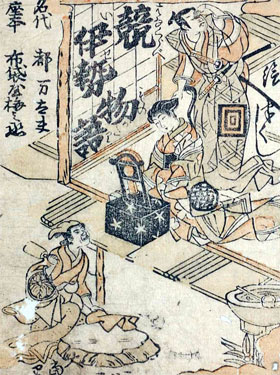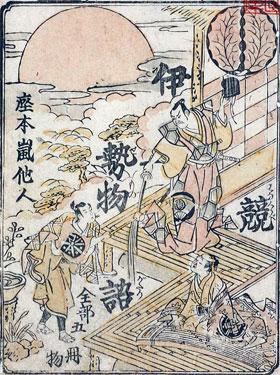| HADE KURABE ISE MONOGATARI |
| Play title | Hade Kurabe Ise Monogatari |
| Author | Nagawa Kamesuke I |
| History |
Nagawa Kamesuke I's drama "Hade Kurabe Ise Monogatari" was premiered in the 4th lunar month of 1775 in ďsaka at the Naka no Shibai [more details]. It was based on the rivalry between the two imperial princes Korehito and Koretaka, sons of the Emperor Montoku, during the Heian Jidai. it had also a link to the famous "Ise Monogatari", a collection of poems focusing on the legendary lover Ariwara no Narihira. Two Chikamatsu Monzaemon's dramas, "Koretaka Korehito Kurai Arasoi" and "Izutsu Narihira Kawachi Gayoi", were also both influential in the creation of "Hade Kurabe Ise Monogatari". It was revived by the Omodakaya guild in October 2013 at the National Theatre [casting]. |
| Structure |
The original drama was in 7 acts. 3 scenes are still in the current Kabuki repertoire: "a Tea Stall on the Nara Highway" and "the Tamamizu Pond on the Nara Highway" from the 5th act and "Koyoshi's House in Kasuga Village" from the 6th act. |
| Key words |
Ennosuke Shijűhassen Fukkatsu T˘shi Ky˘gen Jűhachiban Heian Jidai Ise Monogatari Jidaimono Ki no Aritsune Koto Migawarimono ďch˘mono ďdaimono Nara Kaid˘ |
| Summary |
A Tea Stall on the Nara Highway A group of dyed silk cloth vendors including a woman named Shinobu and Shinobu's newly-wed husband Isonokami Mameshir˘, comes to a tea stall near the Tamamizu Pond together with Ny˘hachi, a porter whom Mameshir˘ has hired. While they are taking a rest in the stall, Kawashima Tenzen, the local magistrate, comes and, calling out Gosaku (the owner of the tea stall), he tells him that the Tamamizu Pond makes a strange sound because there lies at its bottom the Sacred Mirror, which, with the Sacred Jewel and the Sacred Sword, are the three Imperial Regalia. He orders Gosaku, if he finds anyone attempting to steal the Mirror, to call the villagers by beating a drum, arrest him and bring him to the local magistrate's office. Since whoever possesses this precious symbol of Imperial power is in a strong position to secure the Throne, the two sons of the reigning Emperor, Princes Koretaka and Korehito, are both eager to get hold of it. Born of two different consorts of the Emperor, the half brothers are antagonistic to each other especially because Prince Korehito, the younger of the two, has been designated as Crown Prince. When Kawashima Tenzen goes away, Mameshir˘, who is sympathetic to the cause of Prince Korehito, collides to his wife that he is, in fact, planning to secure the Sacred Mirror for the sake of the prince but Shinobu strongly opposes the idea, reminding him of the magistrate's stern warning. Gosaku, who has heard this argument, comes out and declares that he will take them both to the local magistrate's office. He is interrupted, however, by Ny˘hachi, the porter, who knocks him down. Grateful to Ny˘hachi, Mameshir˘ and Shinobu hurry away before any more trouble can be caused. The Tamamizu Pond on the Nara Highway Actually, Ny˘hachi himself has been planning to steal the Sacred Mirror in conspiracy with Gosaku. As soon as Mameshir˘ and Shinobu have left, Gosaku, who pretended to have been killed by Ny˘hachi, "revives" and guides Ny˘hachi to the place where the Mirror is supposed to be lying. As if to express Heaven's wrath at the desecration of the waders a storm breaks out but, undeterred, Ny˘hachi dives into the pond and rises with the Mirror in his hand. In the meantime Shinobu has invented an excuse to leave her husband and has secretly hurried back to the pond. Knowing how important the recovery of the Mirror is to Mameshir˘, yet fearing that it may have fatal consequences for him whom she loves so much, she has decided to take the risk herself. She arrives in time to see Ny˘hachi come out of the watery, clutching his prize. She attacks him and manages to wrest the Mirror from him but in the struggle Ny˘hachi is left with her torn kimono sleeve in his hand. Koyoshi's House in Kasuga Village Koyoshi, a widow, who lives with her adopted daughter Shinobu and Shinobu's husband Mameshir˘ in the village of Kasuga, talks, in the absence of the young couple, with women visitors from the neighborhood, explaining to them how she started making dyed silk cloth as her family business. Mameshir˘ returns home alone and is surprised to learn that Shinobu has not arrived before him, Ny˘hachi then visits the house and, showing a sleeve of Shinobu's kimono to Mameshir˘, proposes to sell it for an exorbitant price of 100 ry˘. Telling Mameshir˘ to think carefully before refusing to pay the price, Ny˘hachi goes off, leaving the sleeve with a pluzzled and anxious Mameshir˘. Ki no Aritsune, Shinobu's real father and a high official at the Imperial Court, visits the house in a splendid palanquin and, after making his retainers go back, chats amicably with Koyoshi, who has opened him a bowl of soup containing powdered wheat. Seventeen years ago Aritsune and Koyoshi were next-door neighbors in northern Japan. At that time Aritsune was out of Imperial favor and in temporary retirement. To make matters worse, his wife died soon after she gave birth to their daughter Shinobu, so Aritsune had the child adopted by Koyoshi. Then Aritsune went back to the capital where he successfully sought Imperial pardon and was restored to service at Court. When Izutsu, an infant daughter of the Emperor, was to be sent, by order of the Emperor, to the Grand Shrine of Ise, where she was to be brought up to become Chief Priestess, Aritsune secretly took the princess to his residence in compliance with a request of her mother, who was most reluctant to send her little daughter to distant Ise. He pretended to the Emperor that Izutsu had gone to Ise. Izutsu has grown up under Aritsune's care and is now in love with Narihira, a handsome aristocrat. She is, however, troubled by Prince Koretaka's demand that she come to the capital to marry him. Izutsu, who never wants to obey the order, is now hiding herself in Koyoshi's house together with Narihira. Toward evening a tired and bedraggled Shinobu returns and proudly hands over the Sacred Mirror to Mameshir˘. Now the Strange offer of Ny˘hachi to sell the torn kimono sleeve for 100 ry˘ is clearly understood by Mameshir˘ as blackmail, It is a hint that, unless bribed, Ny˘hachi will betray Shinobu to the authorities. Now that the arrest and punishment of Shinobu seem inevitable, Mameshir˘ advises her to induce Koyoshi to disown her in order to save the old woman from punishment as Shinobu's close relative. Shinobu provokes a quarrel with her by behaving as badly as possible but in spite of the provocation Koyoshi remains tender and kind to Shinobu. Aritsune comes out of the inner room to advise Koyoshi to disown Shinobu, saying he wishes to take Shinobu to the capital and make her pretend to be Izutsu, Chief Priestess of the Grand Shrine of Ise. Koyoshi, however, adamantly refuses to agree. Kawashima Tenzen, the local magistrate, then visits the house together with police officers to arrest Shinobu. Aritsune tells Tenzen that he himself will arrest Shinobu and hand her over to him. Koyoshi in surprise tries to interfere when Aritsune says that so long as Shinobu remains Koyoshi's daughter, not agreeing to become Chief Priestess, he, as a high official at the Imperial Court, has to arrest her. Koyoshi is thus compelled to agree to disown her daughter. Aritsune then makes Tenzen withdraw, saying he will keep the criminal in his custody for a while. When asked by Koyoshi what will happen to Mameshir˘ if Shinobu goes to the capital, Aritsune tells her that he will adopt Mameshir˘ as his son. Overjoyed at what she considers to be a sudden elevation of the young couple in status, Koyoshi goes into the kitchen to prepare for an impromptu feast. Aritsune makes Shinobu wear a beautiful court dress he has brought with him and helps her dress her hair. He then draws his sword and tells a scared Shinobu that she must be killed in place of Izutsu. Mameshir˘ comes out of the inner room, prepared to kill himself in place of Narihira, who once obtained an imperial pardon for Mameshir˘'s father when he was charged with a serious offence. Unaware of the sad fate awaiting Shinobu and Mameshir˘, Koyoshi jubilantly comes from the kitchen and, separated by a folding screen placed by Aritsune, hears the koto played by Shinobu. At the end of the performance Aritsune beheads Shinobu. Mameshir˘ kills himself. Koyoshi's joy and pride in the noble future which she believed were to come to Shinobu and her husband are turned abruptly to grief as she mourns the death of the young couple, joined by Izutsu and Narihira. Aritsune tells her that the sacrifice was necessary for the sake of peace in the country. He delivers the Sacred Mirror to Narihira, who is sympathetic to Prince Korehito. Ny˘hachi appears and says that he will report the planned deception to the authorities. Aritsune kills him by throwing a dirk at him as he tries to run away. He asks Koyoshi to deliver Ny˘hachi's body to the local magistrate as that of the person who violated the ban on Tamamizu Pond. Aritsune leaves the house with the severed heads of Shinobu and Mameshir˘ to present them to the authorities as those of Izutsu and Narihira. |
 |
 |
|
The actors Anegawa Shinshir˘ III (bottom/left), ??? (center) and Ichikawa Danz˘ IV (top/right) playing the roles of Koyoshi, Shinobu and Ki no Aritsune in the drama "Hade Kurabe Ise Monogatari", which was staged in Ky˘to in the 3rd lunar month of 1793 |
The actors Mimasu Tokujir˘ I (bottom/left), Onoe Kikugor˘ I (top/right) and Kagaya Kashichi I (bottom/right) playing the roles of Mameshir˘, Ki no Aritsune and Shinobu in the drama "Hade Kurabe Ise Monogatari", which was staged in the 4th lunar month of 1783 at the Naka no Shibai |
|
|
| Contact | Main | Top | Updates | Actors | Plays | Playwrights | Programs | Links | FAQ | Glossary | Chronology | Illustrations | Prints | Characters | Derivatives | Theaters | Coming soon | News |